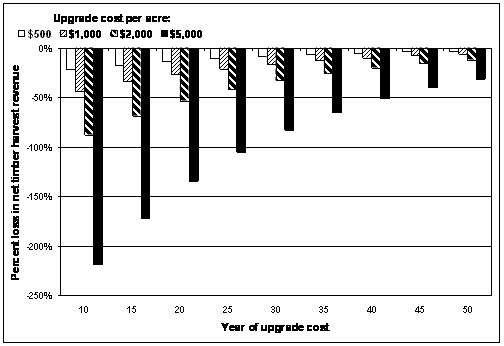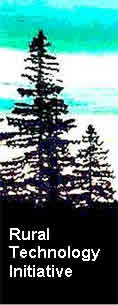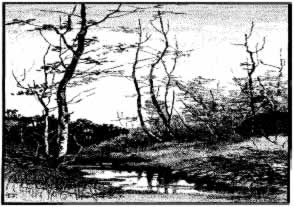 |
 |
 |
 |


Fall 2002, Vol. 3, No. 1
*Click here for a PDF version*Table of Contents:An examination of potential economic impacts of RMAPs and required road upgrades on small forest landowners: by Kevin ZobristRTI Director's Notes: by Bruce LippkeAfter Decades of Investment in Douglas Fir Plantations, is it Time for Forest Landowners to Consider Planting Alder and Cedar? by Larry Mason, RTI CoordinatorAdvanced Quality Control and Standardization Technology for Better Special Forest Products Management: by Dr. Moris Silber and Bruce Davitt, WSUPublications Online! WSU Publications Now Avaiable to View, Download, or Print: |
|||||||||||||||||||||||||||||||||||||||||||||||||
| Plan (RMAP) that outlines how their
forest roads will be brought into compliance with the new regulations.
Landowners must submit an RMAP before harvesting timber, and
all landowners must submit an RMAP by 2005. Any road upgrades
prescribed by the RMAP must be completed by 2015. Road upgrade
cost estimates from the Small Business Economic Impact Statement
(summarized in RTI Fact Sheet #4) indicate that compliance with
the new requirements could be very expensive. While legislative
efforts are underway to modify the requirements, the economic
problems posed by roads cannot be ignored, so it is important
that we better understand these impacts.
Road upgrade costs can cause economic hardship in two ways. The road upgrade costs may significantly reduce a landowner's return on his or her forestry investment. This is reflected by a reduced net present value (NPV) to the investment in forest management. The road upgrade requirements may also pose a cash flow problem. Forest management is a unique enterprise because of the periodic, long-term nature of the income it yields. Because of the periodic nature of timber sales, landowners may not have adequate cash available at the time the road is required to be upgraded. This event may force some landowners to harvest their forests sooner or to harvest more than they otherwise would. Landowners without sufficient timber liquidity to raise the cash necessary for the road upgrades may have to borrow money and pay back the costs of the upgrades plus interest out of future timber revenues. For some the option may be to convert the lands to other uses. |
available from governmental compensation and incentive programs. For more information about possible assistance with road upgrade costs contact your local USDA-NRCS or Soil Conservation District, http://www.nacdnet.org/resources/WA.htm.
|
 Figure 1: Impact of compounded road upgrade costs on net timber harvest revenue. This graph shows the percentage of net future timber revenues that would be lost to pay off money borrowed for road upgrades. Because of high carrying costs, road upgrades done earlier in the rotation will have a greater impact. Losses greater than 100% reflect a scenario in which the road upgrades cost more than the timber on the property is worth. |
| The nature of the economic impacts from RMAPs and the associated road upgrade costs are different for Eastside landowners compared to the Westside. Stream density is lower on the Eastside, and ownership size tends to be larger. Thus, road upgrade costs per acre will generally be lower on the Eastside although the total upgrade expenditure for an individual ownership may still be quite high. Multiple-aged forest management is the typical practice in Eastside forests, with landowners doing periodic, light selective harvests. Because of this, it is difficult to evaluate economic impacts in terms of reduced investment returns at a specific point in time. However, cash flow impacts are readily apparent. Periodic revenues from harvest activities are low and landowners may not have adequate cash on hand to cover road upgrade costs. Smaller acreage landowners who harvest sporadically may have to harvest sooner than they had intended or borrow against future harvests in order to finance expensive road upgrades. Larger acreage landowners who can sustain an annual harvest may alsohave to borrow against future harvests if road upgrade costs exceed a given year's harvest revenue. |
To demonstrate the potential economic impacts of RMAP compliance
on both smaller and larger Eastside acreages, consider two
hypothetical examples. Landowner 2 has 100 acres, which
is harvested every 20 years. Landowner 3 has 1,000 acres,
which is large enough to support a sustainable annual harvest
of 50 acres. Both cases assume a selective-harvest yield
of 3 Mbf/acre at a stumpage value of $200/Mbf for total
periodic revenue of $600 per harvested acre. Example 2: Eastside Landowner with 100 acres
|
 Figure 2: Impact of road upgrade costs on revenues from the next harvest. This graph shows the percentage of revenues from the landowner's next harvest that would be lost to pay off money borrowed for road upgrades. The impacts vary depending on how many years are left until the next harvest, with larger impacts resulting from road costs incurred earlier in the cutting cycle. Losses greater than 100% reflect a scenario in which the compounded cost of RMAP compliance exceeds revenues from the next harvest and will require additional cash-out-of-pocket expense. |
 Figure 3: Years of harvest revenue required to pay for road upgrades. This graph shows the number of years the landowner would have to forfeit harvest revenues before road upgrade costs are paid off. |
|
Example 3: Eastside Landowner with 1,000 acresOur example landowner with 1,000 acres has the advantage
of an annual cash flow of $30,000 (based on revenues of
$600/acre with 50 acres harvested/year) to apply towards
road upgrades. However, in some cases this cash flow may
be inadequate to cover the costs of road upgrades, so the
landowner may also have to borrow funds against future harvests.
In this case, the landowner may forfeit several years' harvest
revenue to pay for the road upgrades plus interest. Figure
3 below shows the number of years of sustainable harvest
it would take to pay for road upgrade costs of $25, $50,
$100, and $500 per acre, representing a total cost of $25,000,
$50,000, $100,000, and $500,000 respectively. A 5% real
interest rate is assumed. |
Economic impacts to different landowners will
vary considerably; some may experience little impact at all
but for others the combined impacts of riparian buffers and
RMAP compliance could be substantial. These impacts may reduce
the attractiveness of forestry as both an enterprise and an
investment, which is significant given current concerns about
the rate of non-industrial private forestland conversion to
commercial and residential land uses in Washington. The Department
of Natural Resources estimates that forestlands in Washington
are being converted at a rate of 100 acres/day (Our Changing
Nature, 1999).
|
|
RTI’s objective is to use better
technology to manage forests in rural areas for increased
product and environmental values in support of local communities.
|
![]()
After decades of investment in Douglas
fir plantations, is it time for forest landowners to consider
planting alder and cedar?
|
Traditionally, economists have watched the lumber market as an indicator of national economic health. In bad economic times consumers stop buying houses and a "pent up" demand results that is triggered with the onset of recovery. As home sales increase so do housing starts and the resulting increase in demand for building materials pushes up lumber prices. Historically, increases in log prices have been soon to follow. But today, even with low interest rates and high housing starts, Douglas fir log and lumber prices are low. This paradigm shift may be particularly threatening to the PNW lumber producers, as this region has high production costs that limit competitiveness when compared against other regions (PWC, R.E. Taylor & Assoc., 2002). |
 Source: Log Lines, Forest Product Price Report, Timber Management Plus. Inflation adjusted to Consumer Price Index |
Price IndexRed alder and western red cedar have long been recognized
by tree farmers as good species to plant in areas that are
wet, nutrient poor, infected by Swiss needle cast or root
rot or in other ways unsuitable for Douglas fir. A strong
performance by both alder and cedar log prices when compared
to Douglas fir prices may lead some foresters to consider
planting alder and cedar on their best sites as well. The
above graph displays prices, adjusted for inflation to 2002
dollars, for comparable grades of Douglas fir, alder, and
cedar logs from 1970 to present in the Puget Sound region
of western Washington. |
Seven simulations are displayed here.
|
![]()
 The above display of Net Present Value (NPV) calculations by species shows that western red cedar out performs both Douglas fir and red alder with alder performing better than fir. Many landowners express reluctance to plant western red cedar because of difficulties associated with browse damage. The above simulations include additional cost at time of planting cedar of $320/acre for browse control (tubing). Cedar's remarkable financial performance at present prices would indicate that tree farmers could make even larger investments in browse control strategies and still enjoy returns greater than those of Douglas fir or alder. An examination of Douglas fir simulation outputs shows that, even with increases in growth and the benefits of export price premiums on 20% of the harvest, the 55-year rotation cannot compete favorably with the shorter 45-year rotation alternative. |
 Internal Rate of Return (IRR) for the same simulations reflects the benefit to forest landowners from shorter rotations. In this case, alder on a 35-year rotation is clearly the winner. It is interesting to note that if it takes just 5 more years to complete the alder rotation (RA40) both of the cedar simulations offer better returns on investment. Even the 40-year alder rotation, however, is very competitive with Douglas fir. |
Some ImplicationsDouglas fir may be poorly positioned to compete in the small log production of commodity lumber against less costly product alternatives and imports. Subsequently, prices for small diameter Douglas fir logs may remain low. The closure of large log mills over the last decade has meant that larger Douglas fir logs are worth even less than small logs. The unique properties associated with higher quality Douglas fir trees have experienced declining demand. Prices for larger Douglas fir logs are likely to remain low. Red alder and western red cedar logs provide raw material for niche manufacturers that produce products unique to the PNW. Niche markets more readily absorb regional production costs and appear to be less price sensitive to competition. Alder and cedar are commonly planted in areas unsuitable for fir regeneration. Rising prices and potentially short rotations make red alder and western red cedar very attractive species for forest regeneration investments on sites traditionally planted to Douglas fir. However, unfavorable conditions will limit red alder and western |
Larry Mason, RTI Coordinator
|
Advanced Quality Control and Standardization Technology for Better Special Forest Products ManagementRecent interest in Special Forest Product (SFP) collections has called for a need to improve the quality, efficacy, and safety of medicinal botanicals and herbal nutrient supplements. High quality and consistent SFP have customarily brought a higher market value. Clearly, the harvesters need advanced technologies for quality control and standardization for routine practice. However, due to the traditionally high cost of such technologies and overall low income among the rural SFP community, these technologies are unaffordable. Analyzing tannin content provides a promising approach to measure the quality of Special Forest Products. The main objectives for the project are: 1) To improve and guarantee both sustainability and profitability of the herbal medicine and dietary supplement industry across Pacific Northwest forest ecosystems by implementing an affordable, easily available, and simple to operate quality control and standardization tannin bioassay technology; and 2) To develop a database on tannin content for several of the most profitable medicinal herbs, such as St. John’s Wort, Echinacea, Gingko Biloba, and those with antitumor activity, harvested at specific growing locations, in specific years, under specific environmental, processing, and storage conditions. The Rural Technology Initiative provided funding to Dr. Morris Silber and Bruce Davitt to complete a feasibility study on these objectives. To approach this problem they employed a newly patented tannin bioassay and pioneered its implementation as a simple, low cost, and accurate technology for continuous quality monitoring and standardization of the herbal crops. This appears to be the first time tannin content in Echinacea and several other botanicals has been detected. Detecting tannins is of scientific and practical importance as it may explain the inconsistent pharmacological effects of St. John's Wort, Echinacea, and other herbal therapies usually reported from in vivo studies in animals and humans when administered orally. The project's latest results show that tannin bioassay may be helpful along with assessing quality of the medicinal botanicals and also in making close predictions about their expected pharmacological activity in the body. Longer term, the laboratory bench-top tannin assay procedures should be convertible into a Tanalyzer Technology - a hand-held digital device providing multiple sample screening for tannin directly in the field. |
Why Tannin? Tannins are ubiquitous in the plant kingdom. They are polyphenolic compounds and constitute one of the most important classes of secondary metabolites in plants. When digested as part of plant food, tannins aggressively precipitate the host's proteins. Tannins also display many other biological activities in human and animals (anti-oxidant, anti-bacterial, anti-viral, and anti-tumor) and, therefore, are very important in agriculture, medicine, and nutrition. Many methods for tannin detection and measurement in plants have been proposed including chemical methods and those based on tannin's inherent ability to precipitate proteins out from solutions. The last group of methods is more favorable in ecological, nutrition, and bio-medical studies. There are, however, many drawbacks and pitfalls in the protein-precipitation methods. A unique reagent, alkaline CBB-BSA was invented (US Patent, 2000) and chemically constructed. The big advantage of this reagent is that it can bind tightly to tannins in a concentration-dependent manner with no dye leakage. This allows for immensely increasing the specificity, sensitivity, and accuracy of the analysis, as well as to dramatically reduce its duration (from overnight to 15 min.) and cost (about 10 times). The method has high feasibility proof to be modified into a hand-held digital "Tanalyzer" for in-the-field use by harvesters and pickers.A tannin content database is being developed on various medicinal herbs from diverse locations and environmental conditions. A categorization of data needs has been designed and a database is being assembled for future analysis and study of PNW forest ecosystem medicinal plants. The capacity to provide front line technological support for PNW SFP industries is being enabled through scientific recommendations aimed at improving the standardized growing, harvesting, and processing methods so that consistently high quality herbal medicines and dietary supplements are sustainable and readily available.
|
Rural Technology Initiative Wins National AwardTO: RTI Rural Advisors and supporters:Thanks to your continuing support, The Rural Technology Initiative (RTI) just received national recognition and an award. The National Private Forestry Education Award for 2002 was awarded to UW/WSU for the Rural Technology Initiative. The National Woodlands Association (NWOA) and the National Association of Professional Forestry Schools and Colleges (NAPFSC) presented the award to Bruce Bare, Dean, College of Forest Resources, UW, and Keith Blatner, Chair, Department of Natural Resource Sciences, WSU at the 2002 National Society of American Foresters annual meeting. While we knew we had strong local support, this award will provide national exposure and help sustain the importance for our activities. The recommendation letter leading up to the award was written and submitted by Larry Mason. A huge thank you, Larry, for getting the nomination forwarded on time during a busy period.
|
 |
Publications Online!WSU Publications Now Avaiable to View,
Download, or Print:
|
||
| Fall 2002 Forest Stewardship
Notes at web address: http://ext.nrs.wsu.edu/newsletter/index.htm |
Washington’s Forest Products
Industry: Current Conditions and Forecast 2002 at web address: http://cru.cahe.wsu.edu/CEPublications/misc0484/misc0484.pdf |
|
| Roads on Small Acreage
Forests in Washington at web address: http://cru.cahe.wsu.edu/CEPublications/eb1910/eb1910.pdf |
||
Readers may send comments to:
Bruce Lippke, Director RTI
CFR, University of Washington
Box 352100
Seattle, WA 98195-2100
Phone: 206-543-8684
email: RTI![]() u.washington.edu
u.washington.edu
Janean Creighton, Coordinator RTI News
Department of Natural Resource Sciences
Washington State University
PO Box 646410
Pullman, WA 99164-6410
Phone: 509-335-2877
email: creighton![]() wsu.edu
wsu.edu







